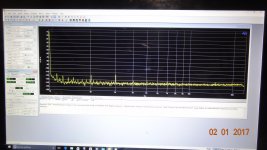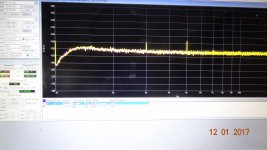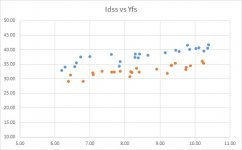Yeah, let's invent the proton tube! But until that reaches mass production, the Fet's are not too bad with regards to the 1/2 mV or so of a MC cartridge it has to deal with.
Btw, I'm not a particle physicist, but I think we may have some issues with the mass of a proton vs an electron, so we'll still have the lack of true symmetry like the N & P Fet's.
Btw, I'm not a particle physicist, but I think we may have some issues with the mass of a proton vs an electron, so we'll still have the lack of true symmetry like the N & P Fet's.
Last edited:
Richard, I don't think you tried hard enough to distinguish between fets and bipolar transistors. I used bipolars primarily for about 5 years before finally using jfets in the same topologies, both preamp, and power amp. I always had more higher order, primarily 5th harmonic show up with bipolars. It is in the inherent transfer function of each device. Of course tubes are even more linear, and if they had a complement I would use them exclusively.
Just saying with topologies I have used --- in practice, it either isnt there or extremely low. In which case it really doesnt matter.
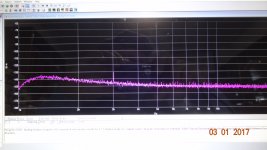
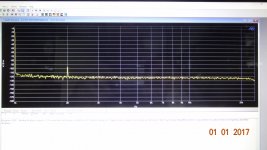
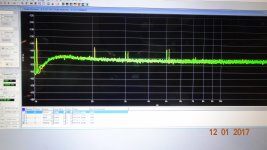
??
THx-RNMarsh
Attachments
Last edited:
Maybe. though I have never seen it happen with my stuff. Anyway, still does not produce miles of harmonics. Only 2H and 3H primarily in anything I see from SOTA amps.
With FET so hard to match closely and their compl..... if the noise and distortion can be designed as low and doesnt show this high order harmonic structure, then, there is NO good reason to use them exclusively.
Just saying I never see anything above 3rd.
View attachment 75233
Btw, I'm not a particle physicist, but I think we may have some issues with the mass of a proton vs an electron, so we'll still have the lack of true symmetry like the N & P Fet's.
Pesky holes and electrons don't behave, there are no truly complementary devices only close.
I'm not making an extreme case for fets, it is just for my 'best' circuits, no holds barred, that I use them almost exclusively. Many of my mid-range Parasound circuits use both bipolar and fets together, and some use IC's primarily, with a bipolar input even.
The circuit(s) that I put up recently were designed when low noise, medium cost complementary jfets were easily available, that is: 35 years ago. In fact, everybody and his brother in Japan was making them back then, and National and Siliconix made plenty cheaper jfets in the USA. Today, all gone! It is just like tubes, and how they were so cheap and available in the 50's and even 60's. Now they are costly.
It just so happens that the manufacturers that I tend to work with, bought large stocks of complementary jfets more than a decade ago when they were still cheap, and that is what we tend to work with.
Generally, I still think the complementary differential jfet input has a number of advantages, and I still insist on using it. This includes low noise, RFI resistance, easy biasing, and extreme linearity. But for second and output stages, I often use bipolars, but I will use mosfets instead, if I can do it practically.
The original Vendetta input stage that I wanted to draw your attention to, is all jfet, but bipolar 2'nd and power supply buffers have been made in the past and work reasonably well. For Constellation, they wanted 'the best possible' so I stuck with jfets and mosfets, as they had a large stock initially. These are limited edition designs, with only a few hundred sold over the years, if that. For real mass production, it would be impractical to use these circuits, so do your own with bipolars, etc.
The circuit(s) that I put up recently were designed when low noise, medium cost complementary jfets were easily available, that is: 35 years ago. In fact, everybody and his brother in Japan was making them back then, and National and Siliconix made plenty cheaper jfets in the USA. Today, all gone! It is just like tubes, and how they were so cheap and available in the 50's and even 60's. Now they are costly.
It just so happens that the manufacturers that I tend to work with, bought large stocks of complementary jfets more than a decade ago when they were still cheap, and that is what we tend to work with.
Generally, I still think the complementary differential jfet input has a number of advantages, and I still insist on using it. This includes low noise, RFI resistance, easy biasing, and extreme linearity. But for second and output stages, I often use bipolars, but I will use mosfets instead, if I can do it practically.
The original Vendetta input stage that I wanted to draw your attention to, is all jfet, but bipolar 2'nd and power supply buffers have been made in the past and work reasonably well. For Constellation, they wanted 'the best possible' so I stuck with jfets and mosfets, as they had a large stock initially. These are limited edition designs, with only a few hundred sold over the years, if that. For real mass production, it would be impractical to use these circuits, so do your own with bipolars, etc.
Fet amplifiers do tend to be cleaner because of input the capacitance, but the actual trends in diy audiophile or expensive projects are to use very high frequency or slew rate amplifiers but tamed enough to do it audio which is mostly based on bipolar transistors.
What i found really interesting is that Fet transistors do tend to sound darker or very clean because of their inner capacitance which some would easily interpret as not "airy " enough while bipolars do tend to oscillate if not compensated properly and what most people would consider to be the case of too many high order harmonics which are inaudible, are in fact oscillations and intermodulation harmonics.
Give a bjt transistor in high gain a simple base-collector miller capacitor high enough to cut those parasitic frequencies , use current feedback on it and you find the "Fet sound"
What i found really interesting is that Fet transistors do tend to sound darker or very clean because of their inner capacitance which some would easily interpret as not "airy " enough while bipolars do tend to oscillate if not compensated properly and what most people would consider to be the case of too many high order harmonics which are inaudible, are in fact oscillations and intermodulation harmonics.
Give a bjt transistor in high gain a simple base-collector miller capacitor high enough to cut those parasitic frequencies , use current feedback on it and you find the "Fet sound"
Last edited:
.but the actual trends in diy audiophile or expensive projects are to use very high frequency or slew rate amplifiers but tamed enough to do it audio which is mostly based on bipolar transistors.
.
Give a bjt transistor in high gain a simple base-collector miller capacitor high enough to cut those parasitic frequencies , use current feedback on it and you find the "Fet sound"
Yes, all my circuits are fast Current-Mode operated for the past 40 some years. Like JC, you find a topology that works well and you keep it until something better is found. Maybe put some lip-stick on it (Cascode et al). I mentioned this a few years ago here which created a fire storm and started another forum on designing high SR and ultra low distortion amps. I said that I noticed all the top models of mfr (SState) had used a CMA topology. Recently, I showed why high linearity well past audio was beneficial especially with CD players and DAC HF byproducts of substantial amplitudes. .... connecting the dots for yall. .
You're welcome.
THx-RNMarsh
Last edited:
Pesky holes and electrons don't behave, there are no truly complementary devices only close.
Toshiba complements are very close, except for capacitance.
I guess it depends on the quantification of "close".
A few years back, I bought a random batch of 2 x 24 pcs. 2SJ74/2SK170 BL from eBay; no idea if they're real or fake, but the numbers look fairly decent, per sex.
However, if I wanted to make complementary pairs on both Idss and Yfs, it gets tricky. From the attached chart, it appears that the "natural" spread of Yfs is about 20%, with the "J" always having higher Yfs. I manage to find 3 pairs with <10% Yfs, or 8 pairs with <15% Yfs, the Idss being within <5% in all cases.
Attachments
There are some very good voltage feedback amplifier based on cascodes or other interesting technologies that can do the same but with higher count of components.Yes, all my circuits are fast Current-Mode operated for the past 40 some years.
THx-RNMarsh
Last edited:
There are some very good voltage feedback amplifier based on cascodes or other interesting technologies that can do the same but with higher count of components.
yes, there are now some.... the most obvious way is to buffer the (-) input of a CMA.
-RNm
I guess it depends on the quantification of "close".
A few years back, I bought a random batch of 2 x 24 pcs. 2SJ74/2SK170 BL from eBay
The Beta parameters are not the same so Yfs at the same drain current can not be the same if you simply try to match only Idss. So some folks pad one flavor with a small resistor as windage or degenerate with a small pot to tune up the result. This can not happen with bi-polars gm vs Ic is fixed in the physics.
Sorry, Richard, but, you know, acronym allergy ... "CMA", " mfr " ?yes, there are now some.... the most obvious way is to buffer the (-) input of a CMA.
post 9yes, there are now some.... the most obvious way is to buffer the (-) input of a CMA.
-RNm
https://www.diyaudio.com/forums/pass-labs/262821-class-ap-amplification.html#post4077413
page 14
http://www.ti.com/lit/ds/symlink/lm6172.pdf
page 1
http://www.ti.com/lit/ds/symlink/opa1611.pdf
Sorry, Richard, but, you know, acronym allergy ... "CMA", " mfr " ?
IEEE term for the topology. Others here like to call it CFB amp.
-RNM
Last edited:
Feedback to emitter or a cathode isnt a CFB mode of amp operation.
-RNM
Adding an extra pole in the feedback loop is-it really in the spirit of CFAs (CMAs)yes, there are now some.... the most obvious way is to buffer the (-) input of a CMA.
Doing this, what benefit do-you expect, comparing to Long Tailed Pairs ?
what do you mean by that?
The best, accurate and clearest description I have read in a long time is here:
https://www.ovationhifidelity.com/w...-Introduction-to-CFA-Amplifiers-for-Audio.pdf
And the forum Slew Master CFA vs VFA forum.
THx-RNMarsh
Last edited:
well Sir...cfa...cfb...too many short names...Please tell me again what you really wanted to tell!Feedback to emitter or a cathode isnt a CFB mode of amp operation.
-RNM
- Status
- Not open for further replies.
- Home
- Member Areas
- The Lounge
- John Curl's Blowtorch preamplifier part III
